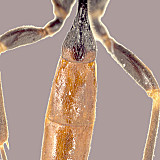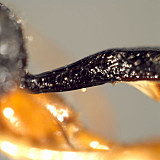Nehomaspis Heinrich, 1949: 15. Type species: Nehomaspis alpinus Heinrich by subsequent designation of Townes et al. (1965: 242). Synonymized by Townes et al. (1965: 242).
Homaspis Förster, 1869
Twenty-one valid species are listed by Yu et al. (2012).
The above description is modified from Townes (1970) and was based largely on one North American and two eastern Palaearctic species in the Texas A&M University Collection.
The following hosts and references for those hosts records are from Yu et al. (2005).
Acantholyda erythrocephala (Aubert 2000)
Acantholyda erythrocephala Pinus resinosa (Asaro and Allen 1999)
Acantholyda erythrocephala Pinus strobus (Asaro and Allen 1999)
Acantholyda luteomaculata (Barron 1990)
Acantholyda maculiventris (Barron 1990)
Acantholyda posticalis (Aubert 2000)
Cephalcia (Martinek 1989; Barron 1990)
Cephalcia abietis (Sedivy 1967; Jahn 1978; Eichhorn 1988; Martinek 1989, 1990; Kanecka 1993, 1995; Eichhorn and Bogenschutz 2000; Kasparyan 2002)
Cephalcia arvensis (Martinek 1991)
Cephalcia lariciphila (Aubert 2000)
Pamphilius depressus (Hinz 1961)
Pamphilius hypotrophicus (Strand 1915; Scheidter 1916; Hedwig 1962)
Pamphilius latifrons (Shaw et al. 2003)
Pamphilius ochrocera (Barron 1990)
Pamphilius vafer (Villemant 1982; Aubert 2000 )
There are no specimens currently determined for this OTU, or those specimens determined for this OTU are not yet mappable.
This work would not have been possible without the groundwork provided by Ian Gauld’s study of the Australian and Costa Rican faunas, and we are particularly grateful for his assistance in many aspects of this study. We also thank the following curators for extended loans of the material used for this study: David Wahl of the American Entomological Institute and Andy Bennett of the Canadian National Collection. We also thank David Wahl for useful feedback throughout our study. Matt Yoder provided considerable assistance with databasing issues, and our use of PURLs (http://purl.oclc.org) in this regard follows the example of their use in publications by Norm Johnson. Heather Cummins, Matt Clark, Patricia Mullins, Caitlin Nessner, Amy James, and Cheryl Hyde graciously assisted us with image processing, formatting, and literature retrieval. This study was supported by the National Science Foundation’s PEET program under Grant No. DEB 0328922 and associated REU supplement nos DEB 0723663, 0822676, and 0923134.
This material is based upon work at Texas A&M University supported by the National Science Foundation under Grant Number DEB 0328922 with REU supplements DEB 0723663, 0822676, and 0923134. Any opinions, findings, and conclusions or recommendations expressed in this material are those of the author(s) and do not necessarily reflect the views of the National Science Foundation.




